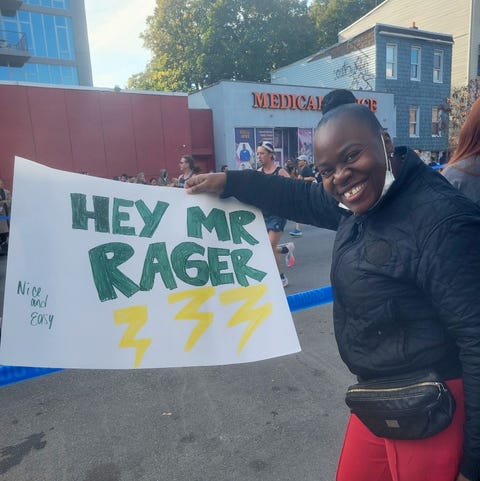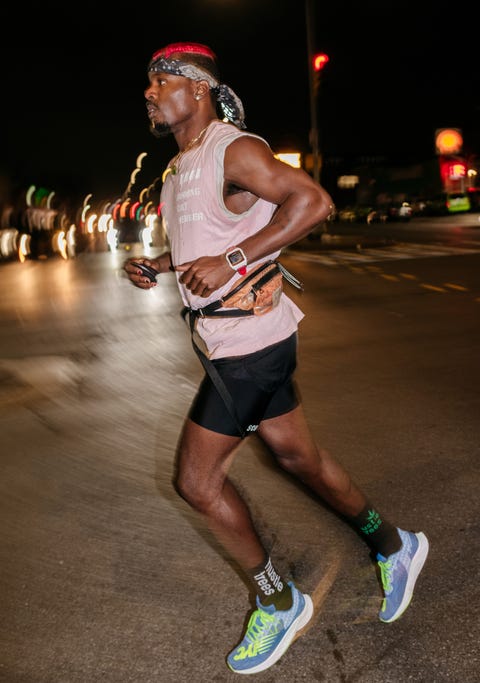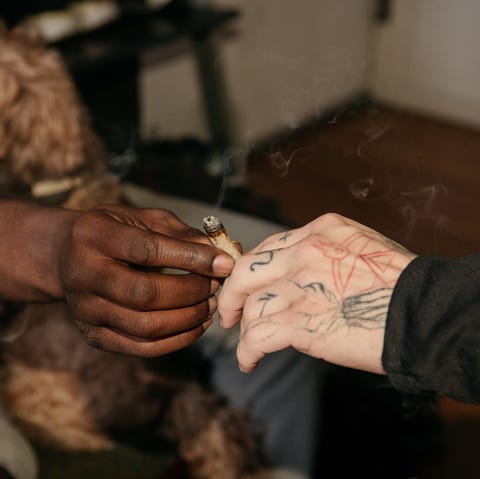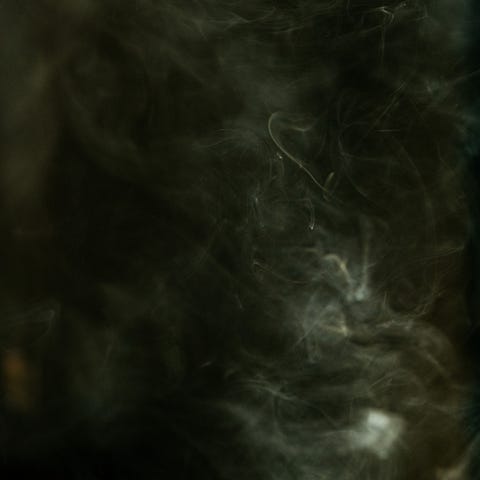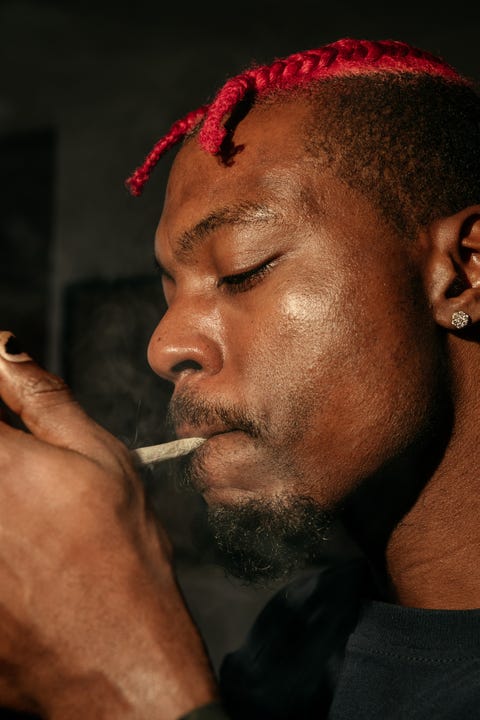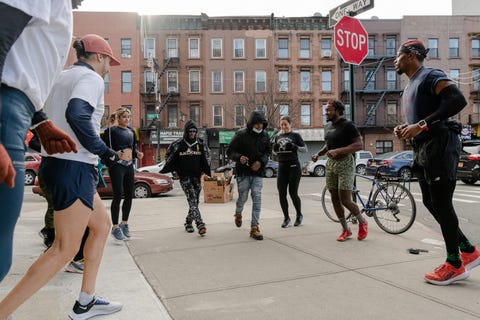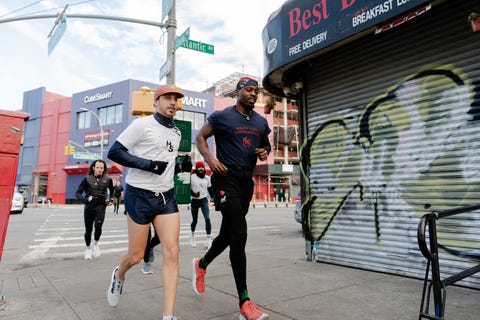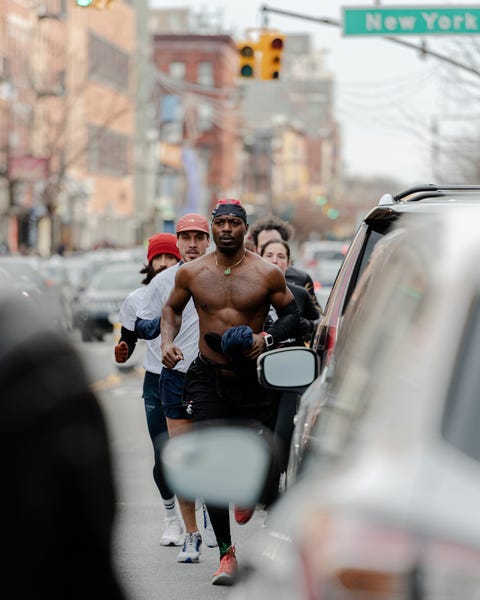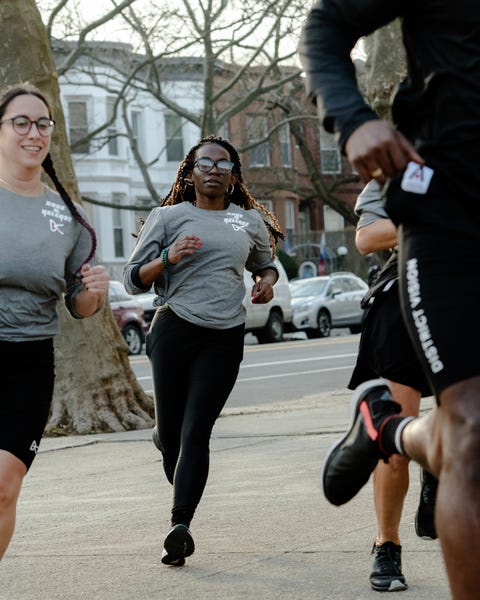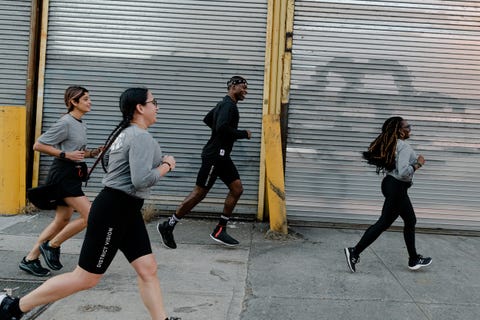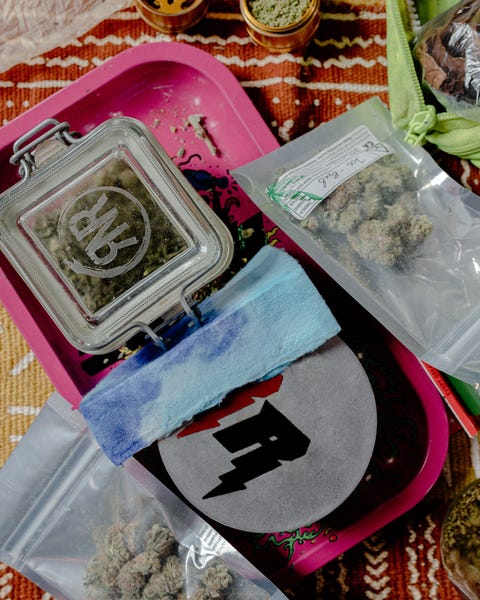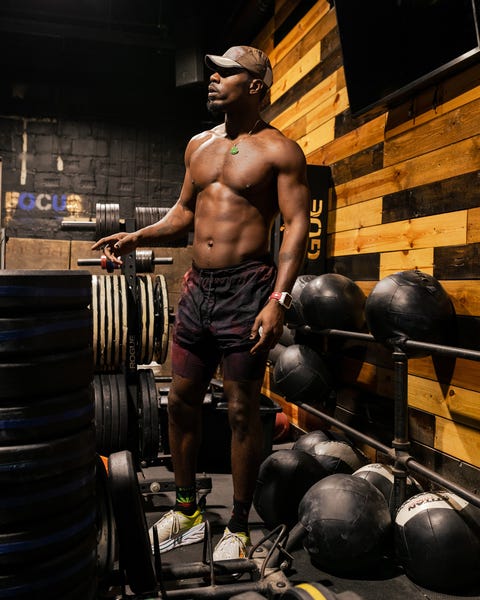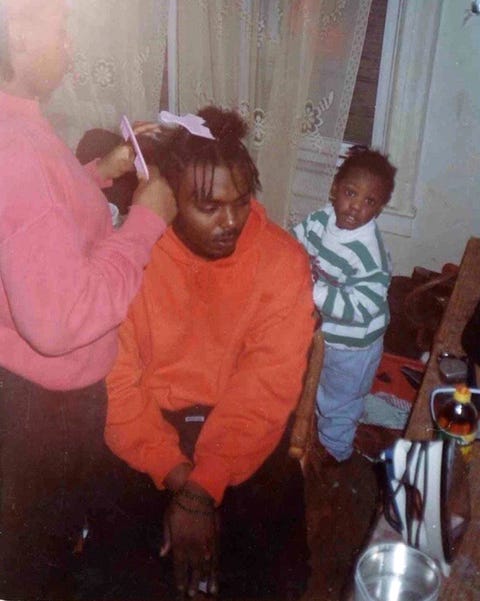Beatrice Richards leans over the tape and cranes her neck. It’s November 7, 2021, and he or she’s staked out a spot on the nook of Lafayette and Bedford Avenues in Brooklyn, simply previous Mile 9 of the New York City Marathon. Her son, Thai, needs to be alongside any second.
Beatrice wasn’t all the time there for Thai. Not like this, not less than. She had him when she was 16; by 23 she was working lengthy hours on the publish workplace. As a single mother, Beatrice was decided to make life for herself and her son. That meant ending faculty, a job, generally a couple of. It additionally meant sacrifices. Beatrice left for work early within the morning, leaving Thai to get himself to high school. Oftentimes he simply stayed residence.
Nonetheless, Beatrice all the time believed in her son. Life may very well be laborious, however he was robust.
Standing at Lafayette and Bedford, Beatrice holds an indication she made: “Hey Mr Rager,” in huge inexperienced letters, underscored by three lightning bolts.
The signal refers to Rage & Release, the cannabis-centered life-style neighborhood Thai based in 2017. The group meets a number of instances a month to meditate, do breath work, share meals, and run the streets of Brooklyn, usually alongside the identical stretch of street the place Beatrice is now ready for her son. Thai says Beatrice was livid the primary time she caught him with weed. He insisted she had nothing to fret about.
Beatrice waves her signal and holds her cellphone in her different hand, able to take a photograph the moment Thai runs by. The second is important. In his late teenagers and early 20s, Thai might have simply landed in jail or been killed. As a substitute, on the age of 30, he’s the literal face of the 2021 New York Metropolis Marathon, featured in its advertising and marketing banners, social media posts, and commercials.
Starring in a serious advert marketing campaign like this one isn’t the type of affect that motivates Thai. His focus is extra intimate. Associates name him the “consummate vibe curator,” and with Rage & Launch he has created house for a neighborhood to coalesce round a typical curiosity in operating and utilizing hashish to not social gathering or to zone out, somewhat to be current and discuss issues like bodily and psychological well being.
However that is greater than only a story about operating and weed. It’s a few mom and a son, and the reminiscence of a father who by no means had the prospect to be a dad. It’s about creating one thing new out of the fabric that’s throughout you, just by recognizing a necessity and forming a neighborhood. It’s about getting misplaced and discovering your means, and doing it by yourself phrases towards the percentages. It’s about resilience.
➡ For limitless entry to an important tales for runners, join Runner’s World+.
Thai and his pal needed to shoot some hoops, however they didn’t have a ball. They have been on the courts close to the Unity Plaza Homes. Thai spent his childhood shuttling from one Brooklyn housing undertaking to a different: a couple of months in Flatbush, a 12 months in Mattress-Stuy, one other in East New York. He is aware of he was in East New York on this specific day; he was residing on Williams Avenue on the time, “one of the vital murderous blocks in Brooklyn,” he says. “There was a subject not too distant the place they’d dump the our bodies.”
He was 7 years outdated, already taller than the opposite boys. He and his pal went inside to get a ball. Down a slender hallway, with institutional paint and linoleum flooring, they reached his pal’s residence. Inside, the toilet door was open; the boy’s father was on the bathroom, a thick rubber tourniquet strapped round his bicep, a syringe plunged right into a bulging vein in his forearm. They discovered a ball and went again outdoors.
Beatrice might or might not have identified the place Thai was. “It was simply, like, I do know my mother loves me and my household loves me, however there wasn’t an excessive amount of engagement,” he says. “I wasn’t like the children despatched to karate college.”
For Thai, household was an assemblage of cousins, grandparents, aunts, and uncles. Thai’s father, Henry, did a whole lot of issues. “He was a hustler,” says Thai. “He lower hair, fastened vehicles, was an amazing pupil and athlete. He did what he might for his household, together with drug dealing, however he was no kingpin.” It was the early ’90s, the peak of the crack epidemic, and on occasion Henry and a pal would purchase bulk portions of the drug and drive to Georgia, or Virginia, or Ohio. They’d spend a couple of days promoting their provide earlier than returning to Brooklyn to re-up. They have been nonetheless youngsters. In 1993, a retailer proprietor in North Carolina mistook Henry for the pal, “who was infamous for robbin’ shit,” Thai says. “They each 6’5″, darkish pores and skin, braids.” The shop proprietor shot Henry within the coronary heart. He died immediately.
Thai has no reminiscences of Henry and is aware of solely that he had African and Native American ancestors. His mom’s household is from Guyana, a rustic with a patchwork of East Indian, African, South American, and European cultures.
Thai discovered to care for himself; he had no selection. From age 7, he was taking Greyhounds alone upstate to Ithaca to go to his uncle. “I all the time been snug simply shifting round on my own,” he says, “shifting ahead in my life.”
By age 10, Thai determined he’d had sufficient of the town. On September 11, 2001, he was in school in Brooklyn when two planes flew into the World Commerce Heart. His instructor wheeled a tv into the classroom and turned on the information. Thai sat at his desk and watched the billows of smoke, the charred bits of workplace paper floating down like confetti, the streams of individuals coming over the Brooklyn Bridge coated in ash. “I used to be like, man, I gotta stand up out of right here,” he says.
Beatrice’s sister, Kim, had lately moved to Greenwood Lake, a tiny hamlet about 50 miles north of the town, and Thai knew she had an additional room. He known as her on the telephone: “Hey auntie, can I come dwell with you?”
And so, a Black child from East Brooklyn discovered himself in white suburbia. Greenwood Lake was serene, however uninteresting. “You already know the suburbs. Both you’re doing sports activities otherwise you’re doing medication otherwise you’re doing each,” Thai says. By center college, most of Thai’s associates had found cocaine, then opioids, and ultimately heroin.
Thai didn’t mess with the coke or the tablets or the H. Not after what he’d seen within the initiatives. “Heroin fucked everyone up so unhealthy, dude,” he says. However he felt remoted; he wanted one thing. He began operating across the city lake, and ultimately found close by Harriman State Park, a 47,500-acre wooded protect with lakeside seashores and miles and miles of trails.
“Operating by way of the woods modified my perspective instantly,” says Thai, who’s 6’4″ and strikes with the poise of a dancer. “The character, the recent air, the rocks, identical to, you already know, dipping and diving over roots and simply being immersed in nothing else.”
Thai favored that he might run alone; he favored being in movement. He didn’t see himself as a runner, although. His future was in basketball. He idolized Reggie Miller and Ray Allen, two of the highest scorers in NBA historical past, and he knew he needed to run if needed to be nice. “Reggie Miller all the time stated in the event you can outrun your opponents, you possibly can all the time rating,” he says. “Similar factor with Ray Allen. So I used to be like, I wish to be like these guys.”
Thai made junior varsity in seventh grade, which allowed him to play on the highschool workforce. He turned associates with a middle named George, one of many few Black youngsters within the space. Thai knew George smoked weed, so at some point he hit him up.
It was a hazy, lovely spring day. “You had the bushes, recent air, the lake was proper there. Common suburban shit, however the vibe was so nice,” Thai says of that first expertise smoking hashish. They shot some hoops and went to George’s home; George’s household had all the pieces. “You go to their crib, there’s chess, there’s Scrabble, there’s drums,” Thai says. “You didn’t simply go to George’s home to smoke; you smoked and also you have been productive, you probably did one thing.”
By eighth grade, Thai believed he was ok at basketball to go professional. The season was nonetheless a few months away, so to get into form he determined to do cross-country. One September afternoon, simply earlier than the bus departed for the primary race of the 12 months, Thai ducked behind the college to smoke a J. Properly toasted, he hopped on the bus, joked together with his teammates, and arrived on the course.
The day was heat, the leaves simply beginning to flip, the rolling hills of the Hudson Valley reducing a pointy profile towards the pristine blue sky. Thai did a couple of drills, strided out, and toed the road.
On the gun, he flew throughout the open subject, his spikes churning up clumps of filth, and assumed the lead. For the following 5 kilometers, not one runner handed him. It was simply him, his breath, his rhythm. He gained the race, he says, in 17:02. “I used to be like, yo, that is the illest factor ever,” he says, his eyes glowing on the reminiscence. “And I used to be like, I don’t assume I ever wish to run sober once more.”
Cannabinoids, excluding CBD, have been on the World Anti-Doping Company’s banned substances listing since 1999, together with EPO, steroids, and cocaine, amongst numerous different substances too obscure to say. Margaret Haney, Ph.D., a professor of neurobiology at Columbia College Medical Heart, the place she additionally directs the Hashish Analysis Laboratory, has described the proof that WADA gives to justify the ban as “terribly weak.” It’s anecdotal at finest and moralistic at worst, and none of it helps the idea that cannabis improves performance. A 2011 paper from WADA claims that hashish slows response instances, decreases coordination, and impairs psychomotor exercise—the identical causes the company makes use of to justify the ban, as hashish could also be “dangerous” to athletes.
This previous summer time, the problem gained worldwide consideration when Sha’Carri Richardson was given a 30-day suspension following a constructive check for THC on the U.S. Olympic Trials, the place she had gained the 100m in 10.86 seconds. It value her the prospect to compete on the Tokyo Olympics, eliciting a cacophony of help and derision from the general public.
In September 2021, WADA introduced that it could evaluate its ban on cannabinoids. In doing so, the governing physique should outline what “efficiency enhancing” even means. Sure, hashish may make an athlete really feel good, however that’s not the identical factor as “performance-enhancing” as we sometimes perceive the time period.
In 2019, the College of Colorado revealed a examine of 605 athletes who use hashish; 80 % of them reported that whereas they didn’t really feel it improved their efficiency, it did improve their motivation and made train extra pleasing. If that makes hashish a efficiency enhancer, in different phrases, then why not antianxiety and antidepressant drugs—or, for that matter, evening’s sleep—none of that are on WADA’s listing?
Chris Barnicle is a former skilled long-distance runner with a half marathon PR of 62 minutes. He started utilizing hashish in center college; now 34, he says that having just a little weed earlier than a run makes him “really feel like Superman. Not that I’ve a lot pace, or that I’m flying, however that every one the destructive ideas simply type of disappear.”
Barnicle equates hashish to one thing else he consumes day by day: espresso. “The caffeine will get my coronary heart fee up, and the hashish goes to mute all of the doubt and switch that into positivity,” he says. In contrast to many substances on WADA’s listing, like HGH—which will increase bone mass and boosts testosterone, which builds muscle—hashish causes no physiological or organic adjustments within the physique. However, Barnicle says, “it’s going to improve, for a sure individual, that positivity, that vibe you want as an athlete to be unstoppable.”
Thai made the varsity basketball workforce in eighth grade. By his freshman 12 months in highschool, scouts had their eyes on him; his future as the following Reggie Miller was coming into focus. It was to be a dream come true, till it turned a dream deferred, then a dream unraveled. Halfway by way of his sophomore 12 months, Thai’s mother determined he ought to transfer again to Brooklyn. The way in which Beatrice remembers it, Kim had a brand new boyfriend who didn’t need Thai round.
Cultural whiplash—once more. After six years of studying to suit right into a largely white neighborhood, Thai needed to relearn how one can match right into a Black one. “After I come again to the hood, I received individuals telling me, you sound like a white dude,” he says. “You already know what I’m sayin’?”
Thai sank right into a melancholy. He stop taking part in ball. It was too laborious to face out in New York Metropolis and he didn’t have a longtime help system and connections like he did upstate. He stored operating, however he didn’t know another runners in Brooklyn. They have been all means older or means whiter. Normally each. He began reducing class. Going from a small college the place his academics appeared out for him, to at least one with huge lessons the place Thai felt nameless, was a “large tradition shock,” he says. “It was tough for me to seek out my groove.” He began performing out. Sooner or later he and a pal stole cellphones from some youngsters after college. No actual motive, he says.
He missed getting misplaced in thought on lengthy runs by way of the woods. “It was, like, I received to determine myself as a Black individual and as a human being general. Operating helped… me really feel like I had management over one thing.” Hashish helped, too, he says. It made him extra introspective. He started to consider his previous, and how one can sq. that together with his aspirations for the longer term. “It’s actually laborious as younger Black males and younger Black girls to seek out stability,” he says, “when it’s a must to consistently take into consideration all of the struggles of your surroundings after which the traumas you grew up with.”
The connection between hashish and psychological well being is hard to pin down. The plant accommodates greater than 100 cannabinoids, whose varied combos and concentrations can create an enormous vary of results, and never all of them are psychotropic. This makes it unimaginable to investigate hashish as a singular substance or to problem categorical truths about its use: Some research counsel that it may be an efficient remedy for melancholy, nervousness, post-traumatic stress dysfunction, and even opioid habit, whereas others have hypothesized that it causes, or not less than exacerbates, these very circumstances. In 2019, Jonathan N. Stea, Ph.D., a psychologist specializing in addictive and psychiatric issues, wrote a roundup of the present analysis for Scientific American, titled “Is Hashish Good or Dangerous for Psychological Well being?” The reply, in keeping with the literature, may be summarized as: ¯_(ツ)_/¯.
Thai began meditating. Generally he’d skip class and go to tai chi; there was a studio not removed from his college, and it beckoned to his curious thoughts. At evening he’d smoke some weed and run loops in Prospect Park, a 526-acre oasis in the midst of Brooklyn, the place it was much less possible he may run into bother. He says he was stopped by the police usually sufficient because it was, all the time for one thing he hadn’t achieved, all the time for becoming the profile: 6’4″, 200 kilos, Black. He needed to play it secure, particularly if he was carrying weed.
New York has a protracted and largely untold historical past with hashish. It was decriminalized in 1977, however that by no means meant it was authorized; it merely meant that having just a little weed wouldn’t lead to jail time, not less than not till the third offense. However you may nonetheless get arrested, and the arrests nearly all the time fell alongside racial traces. NYPD statistics from 2020 present that Black and brown individuals represented 94 % of all arrests for hashish possession in New York Metropolis that 12 months—by no means thoughts that whites use hashish at roughly the identical charges as different teams, in keeping with ACLU information. Each time Thai was carrying just a little weed, in different phrases, he was playing together with his future. “Upon getting a file, issues get laborious,” he says.
New York legalized leisure hashish for 21-and-older adults in March 2021, making it the fifteenth state within the nation to take action. However the regulation has its limits: It’s nonetheless a criminal offense to own greater than three ounces, and something over eight ounces is a felony, punishable by as much as 4 years in jail and a $5,000 superb. The penalties get harsher as portions improve, and are particularly harsh for distribution.
To this present day, Thai has no police file. Name it luck, or perhaps windfall. The safety guard who caught Thai stealing telephones warned him that if he didn’t go away the college that day, the authorities would press prices. Thai transferred to another college in Queens. In his late teenagers, he began promoting sufficient weed that he’d have been charged with a felony if he ever received caught. It was a strategy to make quick money and to make sure that his personal product was pure and clear. Artificial weed was flooding the market on the time, sending individuals to emergency rooms, or into psychosis and seizures on the road. Pure hashish wasn’t totally secure, both. Thai says he recurrently discovered plastic toys, fingernails, human hair, and useless animals in bricks of weed.
Dealing was by no means Thai’s sole hustle. At 18, he began occurring mannequin casting calls; earlier than lengthy he signed with an company, reserving jobs with Nike and Adidas, amongst others. He supplemented his earnings with catering and safety gigs at VIP lounges, non-public events, and galas. “VIP individuals all the time like lovely individuals to take a look at,” he says. He labored at a few of New York’s most unique golf equipment; generally he bought weed to their clientele. Nonetheless, he struggled to discover a place to dwell. He crashed with associates or girlfriends, usually in the identical housing initiatives he grew up in.
Sooner or later in November 2012, simply after Hurricane Sandy tore by way of New York Metropolis and left 1000’s homeless or unemployed, Thai arrange a deal to promote a half pound to somebody he didn’t know effectively. It was a crisp, clear afternoon. Thai met the man on a aspect road in Crown Heights, simply off Utica Avenue. The man led Thai into a big prewar residence constructing, the sort with a number of entrances, a maze of hallways and emergency exits.
Thai’s pulse was regular. Commonplace process. He’d been pushing weight for a couple of years, all the time as a intermediary between a provider and road sellers. He’d been in numerous empty hallways with strangers, exchanged many bundles of money for weed. He not often felt intimidated. He had six inches, not less than, on most different guys, and if he needed to, he knew he might outrun nearly anybody.
Swiftly, “two different homies popped out of nowhere,” Thai says. One pressed the top of a handgun into Thai’s temple; the opposite patted him down. He was trapped. This time, operating wasn’t an possibility. They took the weed and break up. Avenue worth: $1,800.
Thai was offended, however not at those that’d robbed him. “I allowed any individual to have my life of their fingers, and that’s… that made me really uncomfortable,” he says. “I felt like I had humiliated my very own self.” He resolved to pay his provider again and to discover a new path. He knew the place this one may lead. He didn’t wish to wind up like his father. And operating, as all the time, was his rock. It was the “solely means that I’ve been capable of cope,” he says. It might have even saved his life.
Thai went full throttle with Nike. Quickly he was in retailer home windows, and after that, working on the Nike flagship retailer in Flatiron. “That’s the place I met many of the operating neighborhood,” he says.
Between modeling, catering, and safety, Thai was making good cash, and it was all legit. However he nonetheless didn’t have the paperwork to get a spot. Most landlords in New York Metropolis require proof that an residence applicant earns an annual wage 40 instances the month-to-month lease, has a credit score rating of not less than 700, and might present a number of pay stubs proving regular, full-time employment. Thai had the earnings, however nothing else. “You don’t get taught monetary literacy within the hood,” he says. Absent any of that, a guarantor—somebody who cosigns on the lease—will suffice. Thai didn’t have that both.
Thai lastly received an residence with a pal in 2015, the 12 months he turned 25. He’d landed a modeling gig with Nike that paid him $10,000 for one week of labor, sufficient to put down two months’ lease plus double the safety. It afforded him a little bit of stability in an in any other case chaotic life. He started coaching for the New York Metropolis Marathon. He’d utilized by way of the lottery however didn’t get in, so he purchased a bib on-line and ran beneath another person’s identify. He says he completed the race in 2:50, a surprising time for somebody of Thai’s dimension, however celebrations have been short-lived. Not lengthy after that race, Thai and his roommate had a falling out. He was again on the road.
Thai’s health took a success. It’s laborious to take care of a nutritious diet, common sleep patterns, and a constant coaching routine if you don’t have a spot to dwell. However he nonetheless needed to run his hometown marathon, and in 2016 he once more utilized by way of the lottery. Once more, he didn’t get in. He purchased one other bib on-line, unaware that it was counterfeit and that dozens of others had purchased one identical to it. An official on the race begin noticed Thai’s bib within the corral. He was banned from NYRR races for the following two years.
Thai didn’t want NYRR to run. However he did want a neighborhood, and he wasn’t discovering it within the New York operating scene because it existed. He knew he wasn’t alone.
Rage & Launch began small. Only a few individuals at first, assembly as much as run, meditate, and smoke some weed, not essentially in that order. In its first couple of years, it was a aspect undertaking for Thai, one thing he folded into his private model as a mannequin. And although he knew he’d landed on one thing, he didn’t notice its potential. That modified in 2017, when he met Kenisha (Kenny) White.
Kenny had come to New York from Virginia two years prior for a three-day go to and by no means left. She met Thai by way of operating, which she took up after she moved to the town. “I all the time used to say I’d solely run if I used to be being chased,” she jokes.
Thai advised her about Rage & Launch, his imaginative and prescient for what it might grow to be, and the individuals he needed it to serve. Thai’s modeling and safety work had launched him to luxuries he’d by no means identified rising up. For him, that was the core of the issue. “You must concentrate on Black and brown communities, as a result of wellness is completely out of attain for them,” he says.
Kenny had labored in model activation for Zagat and as a program supervisor for The North Face. She had some concepts, and joined as cofounder. She constructed an internet site and created an Instagram account. They wrote a marketing strategy and received critical about the way forward for Rage & Launch. Thai’s aspect undertaking was changing into a mission.
The vibe at a Rage run is chill. Because the runners wait on road corners for lights to alter, a couple of will take turns doing pullups on a stroll signal. Thai may do a set after which drop to the pavement for some curbside pushups. Alongside the best way, he’ll retrieve a protracted, fats joint from behind his ear, and flick a lighter. He’ll take a pull and resume operating.
After a simple jaunt by way of Mattress-Stuy, or Clinton Hill, or to Williamsburg and again, the group will convene in a vacant lot in Crown Heights subsequent to Dean CrossFit. Rows of train mats line the oblong house, a makeshift city sanctuary nestled right into a strip of auto-repair outlets and repurposed garages. Thai will lead a program of post-run stretching, deep respiration, and meditation earlier than sharing the remainder of the joint with whoever desires to partake.
Management comes naturally to Thai. Ronald Peet, a NYC-based actor who began operating with Rage & Launch in June 2020, says he was “fully mesmerized” the primary time he noticed Thai. “He appeared like a superhero and had the power of a teddy bear,” he says.
As central as operating is to Rage & Launch’s backstory, Thai says it’s solely a bit of their grand plan. They wish to open an area in central Brooklyn, not removed from Dean CrossFit, to be accessible to lower-income neighborhoods like East New York and Brownsville. They’ve begun curating artwork exhibitions, holding meditation circles, and creating packages round hashish and wellness training. They’ve even organized dinner events with non-public cooks that pair two very totally different cuisines in the identical meal. They name the dinners Bang Bangs, and like many issues in Thai’s life, he says they have been impressed by the multicultural stew of Guyana.
At one Bang Bang final October, two Brooklyn-based cooks, Toya Henry and Rachel Laryea, ready a six-course meal combining parts of Caribbean and Southeast Asian cooking, with dishes like turnip carpaccio and pickled breadfruit. Thai says he hopes the Bang Bangs will encourage deeper, extra intentional engagement with meals—not not like his strategy to hashish. “Consumption is what people do: devour, devour, devour, devour,” he says. “However we get so caught up within the mainstream that we don’t even know what’s good for us anymore.”
Not one of the dishes on the October Bang Bang was infused with hashish, although it’s normally current at Rage & Launch occasions, together with Bang Bangs. Thomas Llaurado, who’s gone on greater than 20 Rage runs since he moved to Brooklyn in 2019, describes Thai as “the consummate vibe curator,” and an enormous a part of that’s giving everybody the house to form the expertise as they want. “Though hashish is all the time welcomed,” Llaurado says, “it’s by no means pushed on anyone.”
The day began out grey. However by midday it had was a kind of excellent October afternoons, golden, 60 levels within the solar. Thai had invited me over to his place for tea. He lives now in a tidy five-bedroom residence in Mattress-Stuy with Kenny, his cousin CJ, his Aunt Boo (Henry’s sister), and two Shih Tzus. “I used to be blessed sufficient that everybody in our home now has the proper paperwork and credit score scores,” he says.
We’d made plans to go for a run. However first, a cup of tea and just a little sativa—a pressure of hashish identified for its energizing, uplifting results: excellent for a pre-cypher, as Thai calls it. As I sipped the nice and cozy natural concoction he’d ready, we handed a joint backwards and forwards and talked about his sneaker assortment, the provenance of the weed we have been smoking (a small natural farm upstate), and among the analysis I’d achieved for this text. I advised him about Chris Barnicle’s perception in hashish’s skill to mute self-doubt, and Thai nodded. I additionally stated that whereas I’d used hashish myself since highschool and began operating at 23, I’d by no means as soon as run excessive. He nodded once more and smiled. He’d heard that one earlier than.
We gathered our issues and went downstairs. Thai placed on a playlist of ’70s Nigerian funk and ’90s hip hop, channeled by way of a small speaker in his backpack. I requested him what tempo he was trying to do. “Seeing as I’m simply waking up, 7:30s,” he stated. “Sounds good,” I replied. And with that, we set off by way of the streets of Brooklyn.
Instantly, my 46-year-old physique felt lighter than it usually does firstly of a run. We coated the primary mile in slightly below 8 flat, then 6:40, then 6:13. We didn’t discuss rushing up; it occurred organically. I fell into lockstep with Thai’s cadence as he guided us, wordlessly, by way of the leafy blocks of Clinton Hill and Fort Greene, over the Manhattan Bridge, and into Decrease Manhattan. And whereas it didn’t really feel simpler than another run on the similar tempo, it clicked in another way. I felt in excellent concord with myself, with Thai, with the town. Because the route turned extra congested, with individuals and vehicles and meals supply bikes, we appeared to easily float by way of all of it.
On the prepare again to Brooklyn, we talked about organizations like NYRR making an attempt to capitalize on Thai’s picture. He stated he’s completely satisfied to play the sport—“I have to eat too,” he stated—however he’s not naive. “The ‘highly effective Black man’ is fashionable proper now,” he stated. “I do know I’m a token.”
We talked about declarations of “supporting the neighborhood” which have grow to be the style in company messaging at present, about how a whole lot of it’s simply opportunistic woke-washing. He advised me a few state of affairs the place a serious model had requested to accomplice with Rage & Launch on an occasion after which reneged on the final minute, leaving Thai to cowl the $9,500 payment for the house alone. There was no means he might afford it. He didn’t appear offended; he didn’t even appear stunned. He appeared down the size of the prepare automobile, shrugged, and appeared again at me: “They fucked us, bro.”
Two steps ahead, one step again. Story of a life.
Days later, Thai texted me an replace: The corporate was going to honor its association in spite of everything. “They realized it could look unhealthy on their finish,” he wrote.
Beatrice Richards stands on the fringe of the sidewalk and friends down Lafayette Avenue. A smattering of runners morphs into dozens, then a whole bunch, then 1000’s. She is searching for only one. I’d come to observe the marathon with Kenny; assembly Beatrice is a welcome shock. Thai inherited her eyes, sincere and type. Her smile, heat and broad. Her demeanor, calm and direct. I inform Beatrice that I can see the resemblance and he or she laughs. “You need to see his father.”
Inside seconds she’s pulled up a photograph on her telephone, taken when Thai was simply 2 years outdated, not lengthy earlier than Henry was killed. In it, Henry sits on a kitchen chair as Beatrice braids his hair; he wears a vibrant orange sweatshirt, his eyes solid downward. Thai stands behind him sporting a striped shirt, trying straight on the digicam, his eyes vast. It’s a kind of quotidian moments that appear to have been captured solely on movie, earlier than cellphones allowed us to curate our lives in actual time. It isn’t, formally talking, {photograph}. Time has turned it into an ideal one.
Beatrice is true: Thai seems like Henry. He has his cheekbones, his shoulders, his athletic construct. He has Henry’s drive, too, she tells me. “Henry was a go-getter,” she says. He’d been promoting crack for under about six months when he was shot in North Carolina. He was simply making an attempt to feed his household, she says. It was only a short-term factor.
Thai inherited Henry’s trusting nature, too, she says; she hopes it doesn’t damage him. Henry’s pal wasn’t actually his pal, she says. “He killed Henry. It was a setup.” She says the pal swapped his jacket for Henry’s to confuse the shop proprietor. I ask why he would do this. “He was jealous of Henry,” Beatrice solutions, “of what he had. I don’t know.”
Beatrice isn’t stunned that Thai is such a gifted runner; she ran monitor herself. Neither is she stunned by what he’s doing with Rage & Launch. Ambition runs within the household. All these years that Thai was on his personal, Beatrice was busy rising up too. She put herself by way of college when Thai was little, incomes a enterprise diploma at Kingsborough Group Faculty and later taking programs on the John Jay Faculty of Felony Justice. After working the previous 20 years at Rikers Island, New York Metropolis’s notoriously harmful jail, she’s about to retire as a captain within the corrections division. She says she all the time knew, even when she caught Thai with weed, that he wouldn’t land there. He’s all the time identified his limits, she says. “He’s all the time been good.”
As for Rage, “I adore it,” she says. “I simply hope he can get the phrase out, get some extra funding.” I ask her if she is aware of I’m writing this text. She doesn’t. Tashawn’s too modest, she says, utilizing the identify she gave him at start. He hasn’t advised her.
Immediately Thai flies previous mere inches from the curb. He knew Beatrice and Kenny could be there and he made positive to get as shut as doable. Beatrice whoops as she holds her handmade signal excessive within the air and hurries to snap a photograph. Thai pumps his proper fist, offers Kenny a high-five together with his left, and cruises on to Bedford Avenue.
The sub-3 tempo group follows shut behind, not that Thai is paying consideration. He doesn’t want a tempo group. He has his crew, his rhythm. And even when he didn’t, even when he fell off his tempo, even when he pulled a cramp and needed to stroll, he isn’t stressing it. He’ll in the end end in 3:08, precisely what he’d predicted. Later that day, Thai posts a photo on Instagram of himself smoking a joint, sporting his post-race poncho and donning his medal, with the caption: “The stigma round hashish as we all know is altering yearly resulting from science and mf’s like me who showcase something is feasible with the proper life-style. It’s not what you do, it’s the way you do it.”
On Tuesday after the race, round 30 individuals collect outdoors Dean CrossFit. They hug and catch up and congratulate one another on their current marathons. Thai lights a small bundle of sage and welcomes the group into the vacant lot subsequent door. He says a blessing for everybody who ran New York and leads the group in some breath work and warm-up workouts. Then he tells them the route, a simple 3-mile loop up Bedford Avenue and again through Fort Greene, walks outdoors, and lights a J. And with that, properly toasted, he begins to run.

